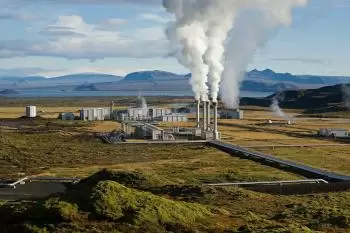
Geothermal energy encompasses the different ways of harnessing the Earth's heat directly or converting it into electricity on a large scale.
It is used to obtain domestic hot water and feed the home's heating system in the domestic domain. On the other side, when the geothermal reservoir is above 100 or 150ºC, it can also be used to generate clean electrical energy, just as solar or wind energy would.
It is a renewable energy source with specific advantages and disadvantages depending on different characteristics. However, despite its pros and cons, we will list the drawbacks of geothermal energy in this article.
1. High initial cost
The main con of geothermal energy in a home is the initial installation cost to extract the thermal energy from under the Earth’s surface.
The process of accessing the underground heat source implies that the first phases of the project are long and economically expensive. For example, the cost of drilling into the ground, installing geothermal heat pumps, heat exchangers, etc., is high.
To carry out a project for a geothermal energy installation, it is necessary to carry out previous studies. These studies require specific machinery and significant investments in the project's initial phase.
In comparison, the cost of a geothermal installation is much higher than installing a natural gas boiler or installing a solar panel.
2. Triggering earthquakes risk
Among the different types of geothermal energy, high-temperature geothermal energy is used in thermal power plants to generate electricity.
The construction of geothermal power plants can affect the stability of the earth. For example, geothermal power plants have caused subsidence in Germany and New Zealand.
Earthquakes can be triggered by hydraulic fracturing, which is an intrinsic part of enhanced geothermal system power plant development.
Why does the earthquake risk increase?
An enhanced geothermal system aims to create a network of fractures in hot rock that is too impermeable for water to flow through. With this network of fractures created, two wells can be used to create a heat exchanger. Cold water is pumped through a well; it is heated thanks to the underground heat, and hot water is extracted from the other end.
Operators who drill a geothermal well casing it with steel tubing using the same process and technology used to build an oil well. High-pressure water is pumped into the well, forcing open existing fractures or creating new ones.
Sometimes these small fractures cause small earthquakes. The problem is when earthquakes get too big.
3. Installation location affects performance
Because geothermal conditions inside the Earth are not always optimal, in some parts, some installations would have such low thermal performance that they would not be viable. This disadvantage is similar to the relationship between wind energy and wind.
Depending on the geological characteristics, some places are better than others for constructing geothermal wells. Rocky terrain, for example, is a significant disadvantage for the construction of geothermal installations.
In the case of large cities, it is more challenging to build geothermal power plants. The main disadvantage, in many cases, is that in cities, the subsoil belongs to the council and is occupied by other services such as sewage, gas, electricity pipes, etc.
Thermal energy cannot be transported as a primary source of heat. It must be consumed in the same place where it comes from.
4. Effects on the environment
In environmental terms, although geothermal energy is considered environmentally friendly and does not generate so many carbon dioxide emissions as fossil fuels, this energy resource can also emit other toxic emissions.
Beneath the Earth’s surface, there are many greenhouse gases. Some of these gases are mitigated towards the surface and into the atmosphere. These emissions tend to be higher near geothermal power plants.
In an eventual accident or leak, hydrogen sulfide can be released in certain places. In those cases, there would also be some risk that toxic substances, such as arsenic, ammonia, etc., could be released and contaminate nearby waters.
Profound geothermal energy can contaminate nearby waters with dangerous substances such as arsenic or ammonia from rocks or water at great depths. However, the gas emissions from geothermal power plants are much lower than from electricity plants based on the combustion of fossil fuels.
Finally, large geothermal installations deteriorate the landscape.
5. This technology is still under development
The geothermal energy sector is still developing. As a result, the number of geothermal resources exploited worldwide is almost insignificant compared with other exploited resources in most countries.
This translates into a disadvantage because they could be better used if the right technology was available and optimal measures to preserve the environment during their use.
Conclusions
Some of the disadvantages of geothermal energy that we know today can be solved long term. However, we must bear in mind that this type of energy is one of the least known.
The number of countries that have implemented it is relatively low; among them are Sweden, Finland, and the United States. In Colombia and Spain, projects with geothermal energy are objectives that they have to develop in their territories in the coming years.